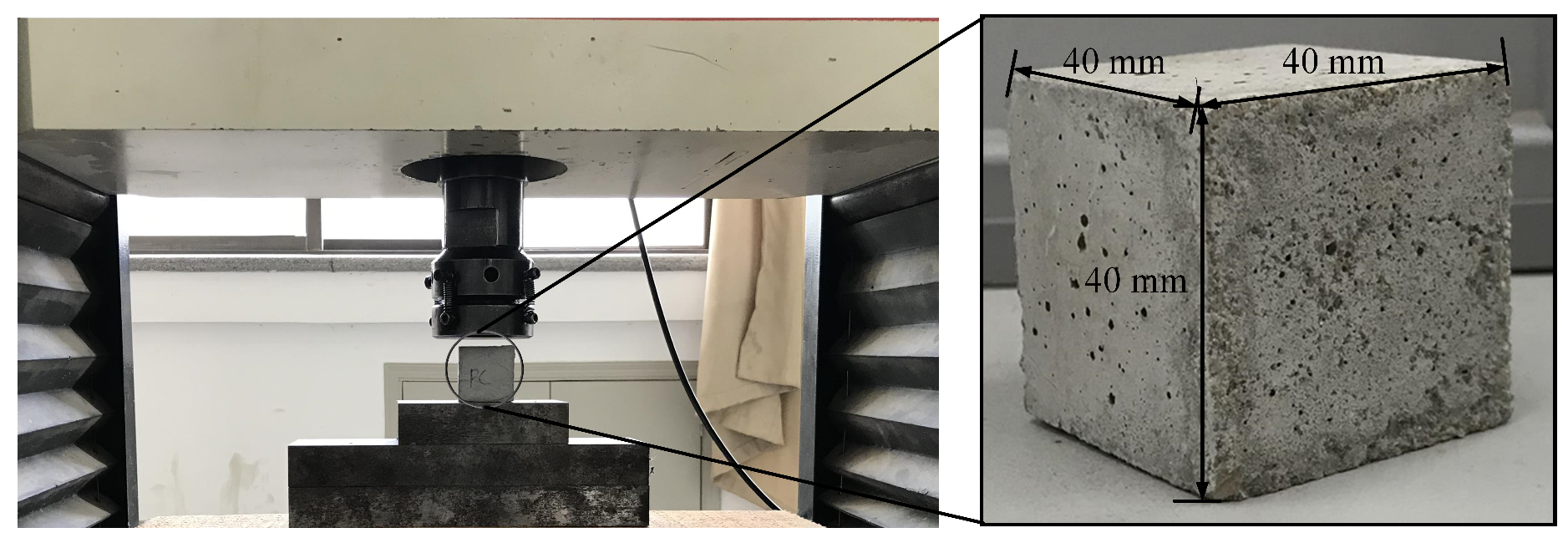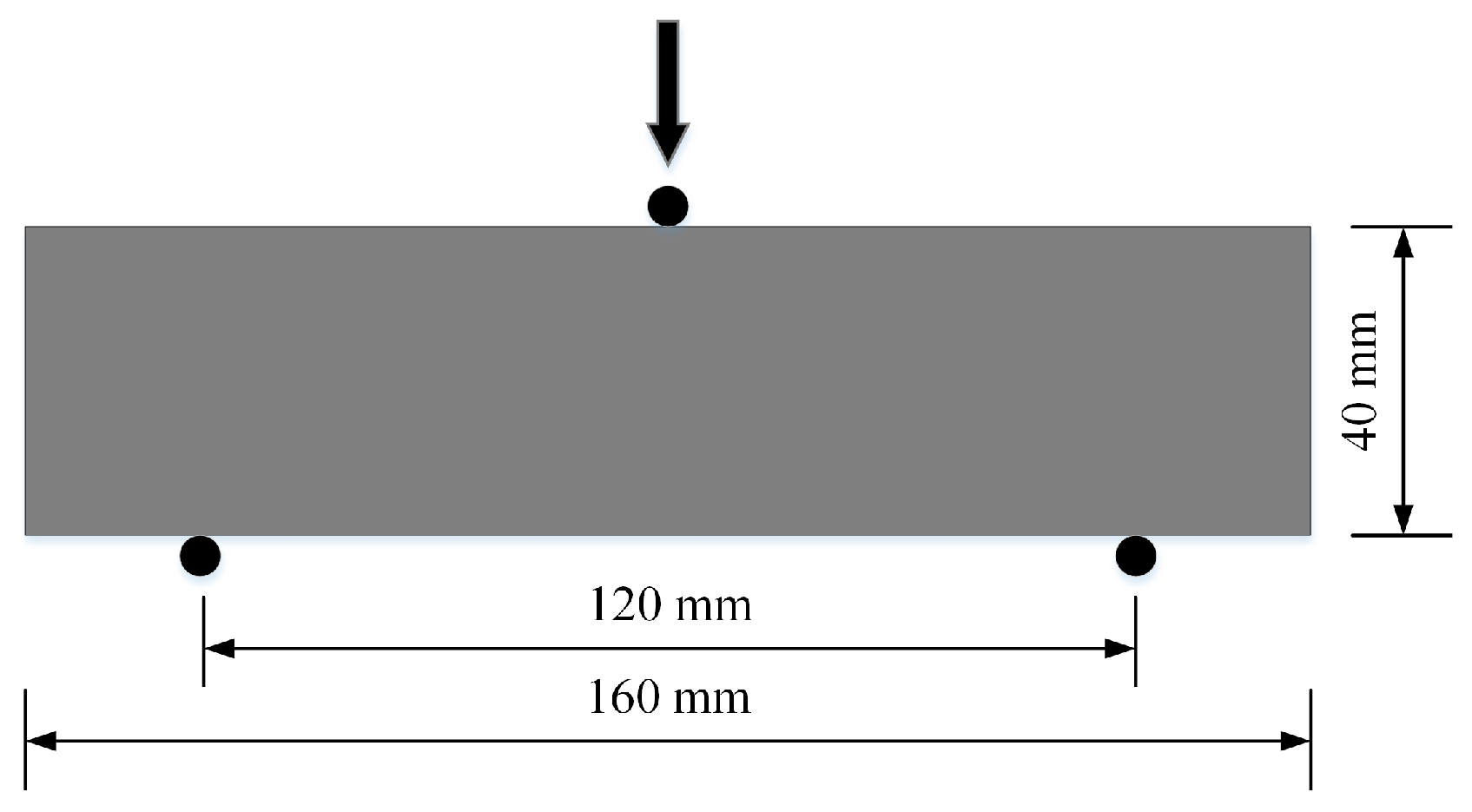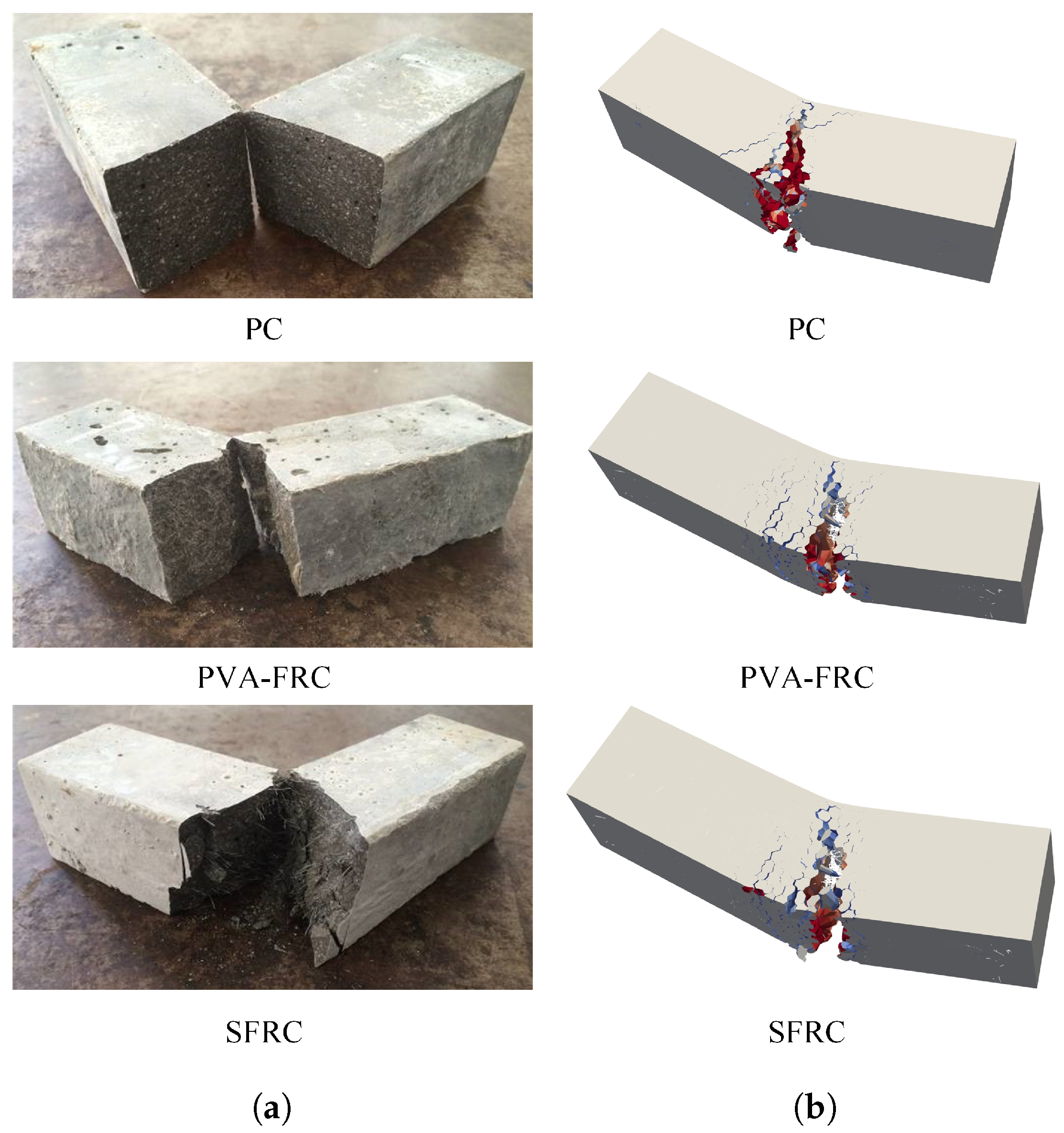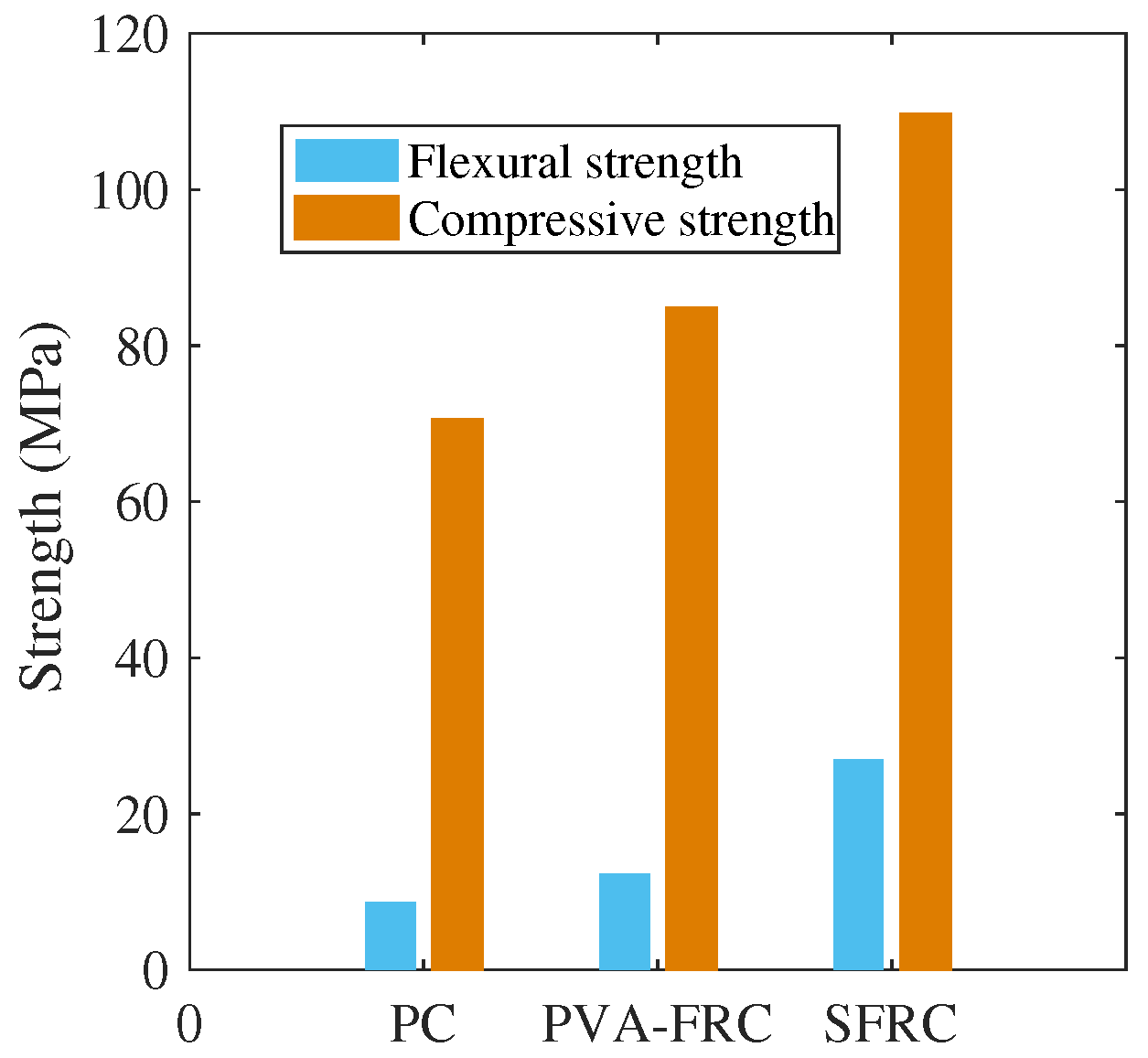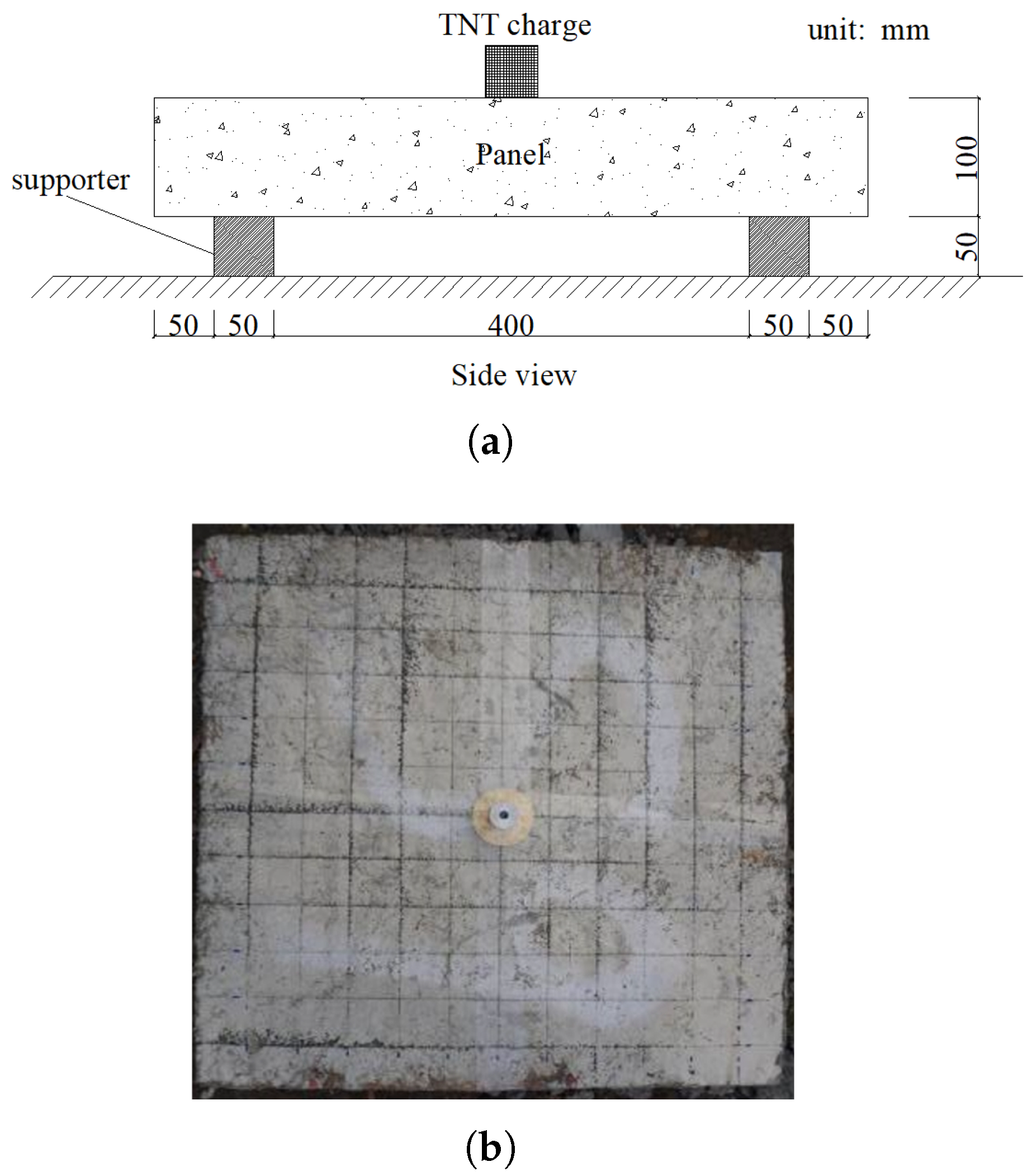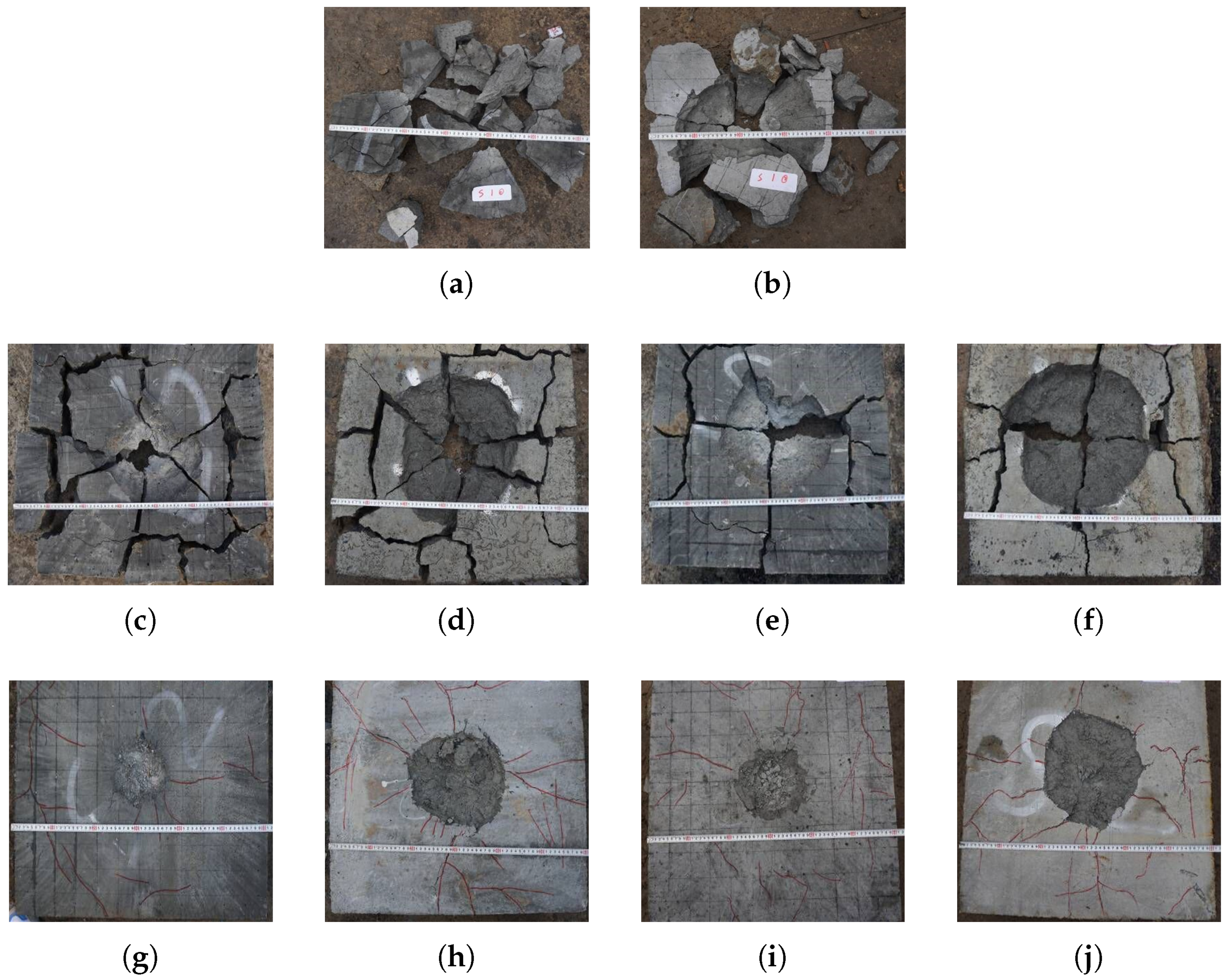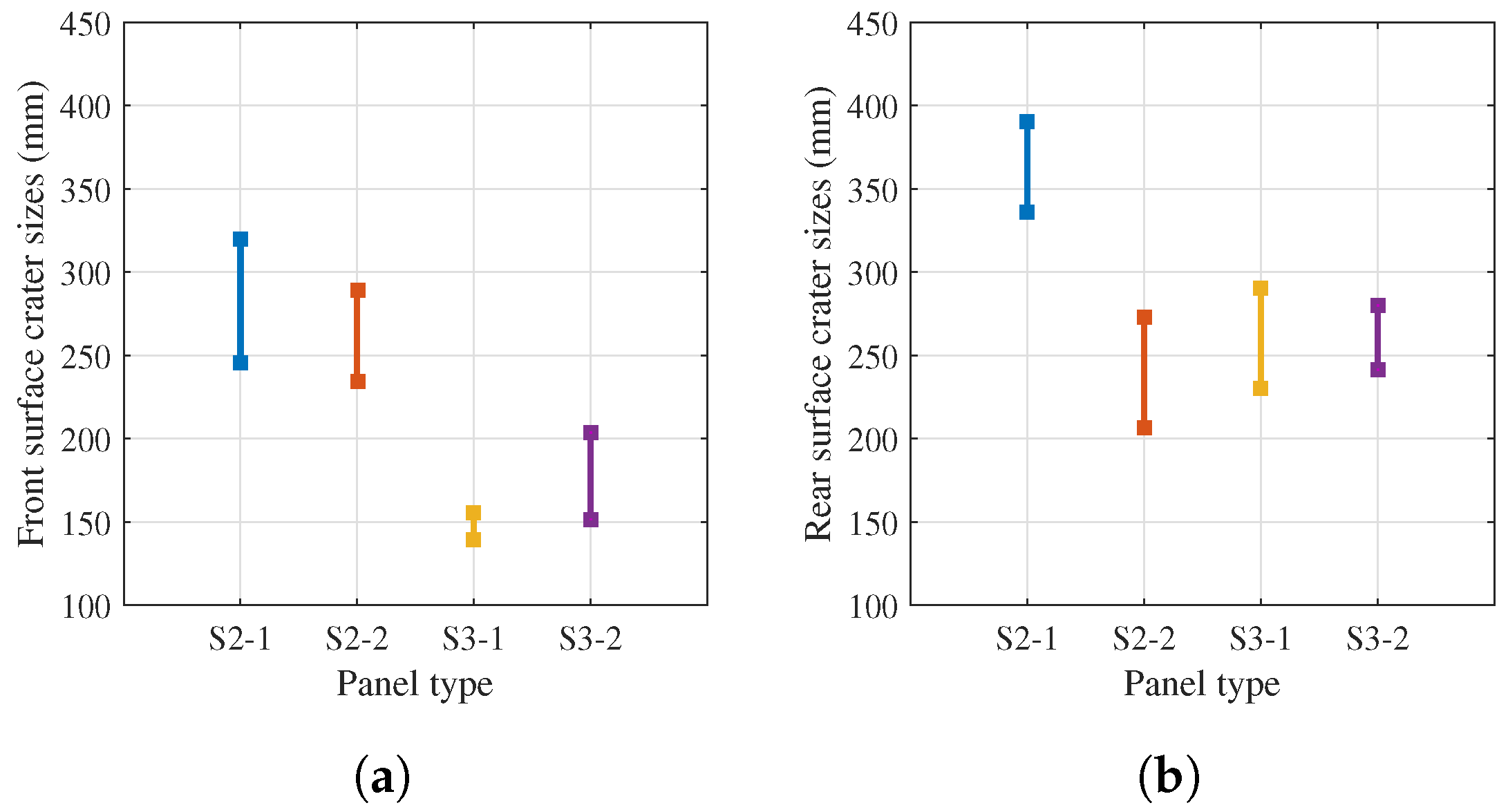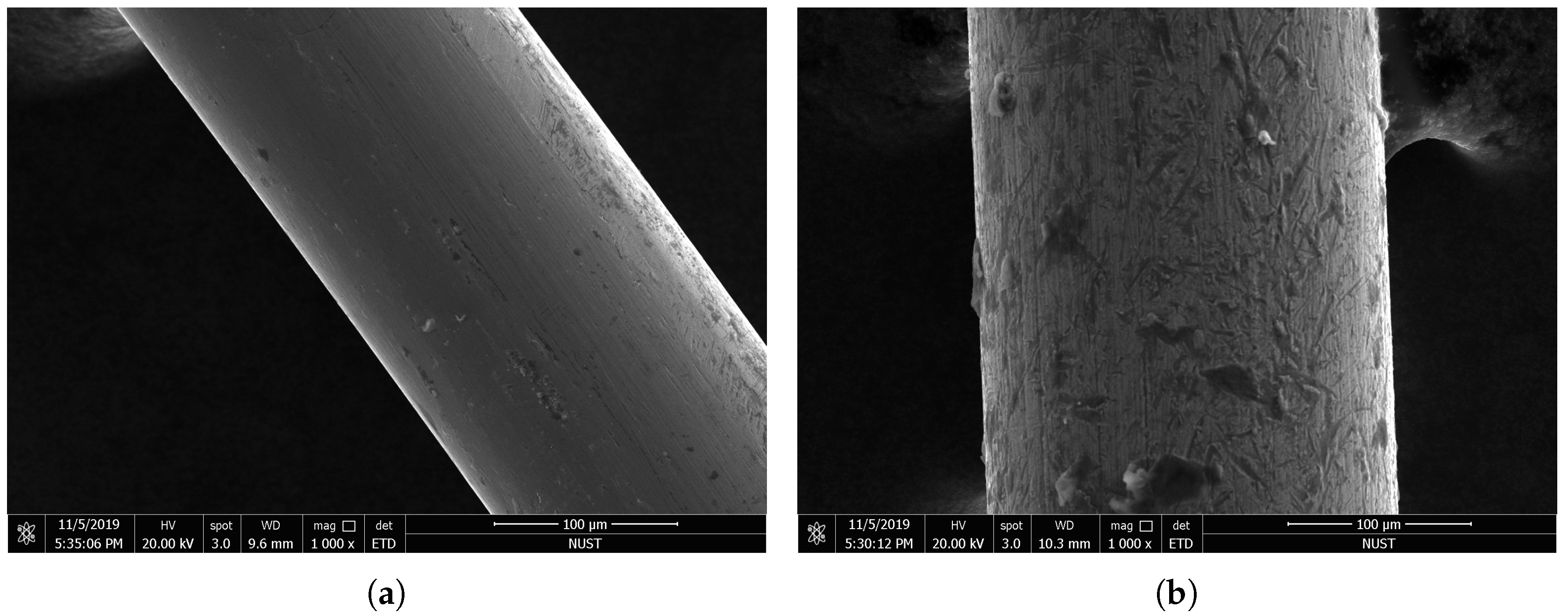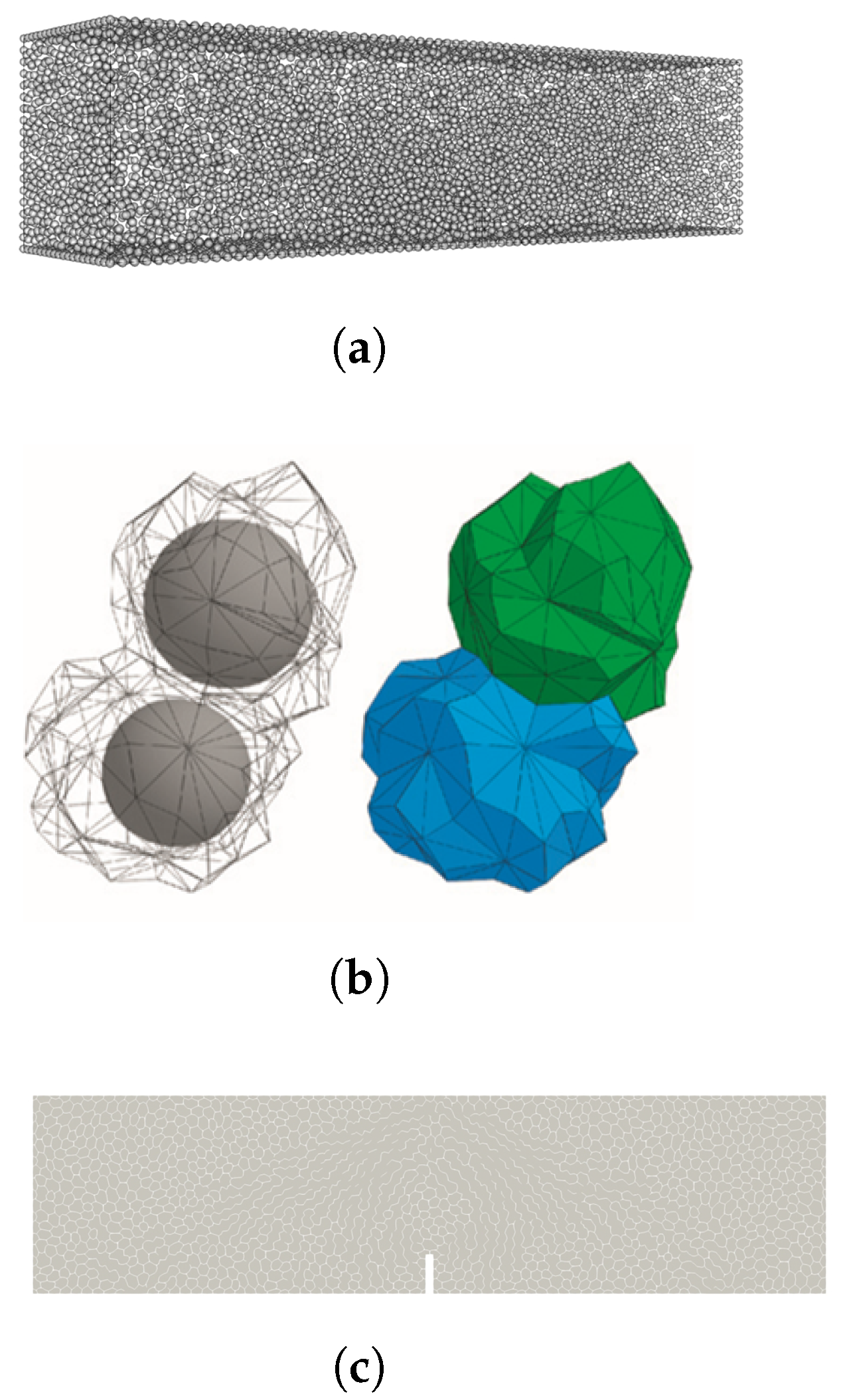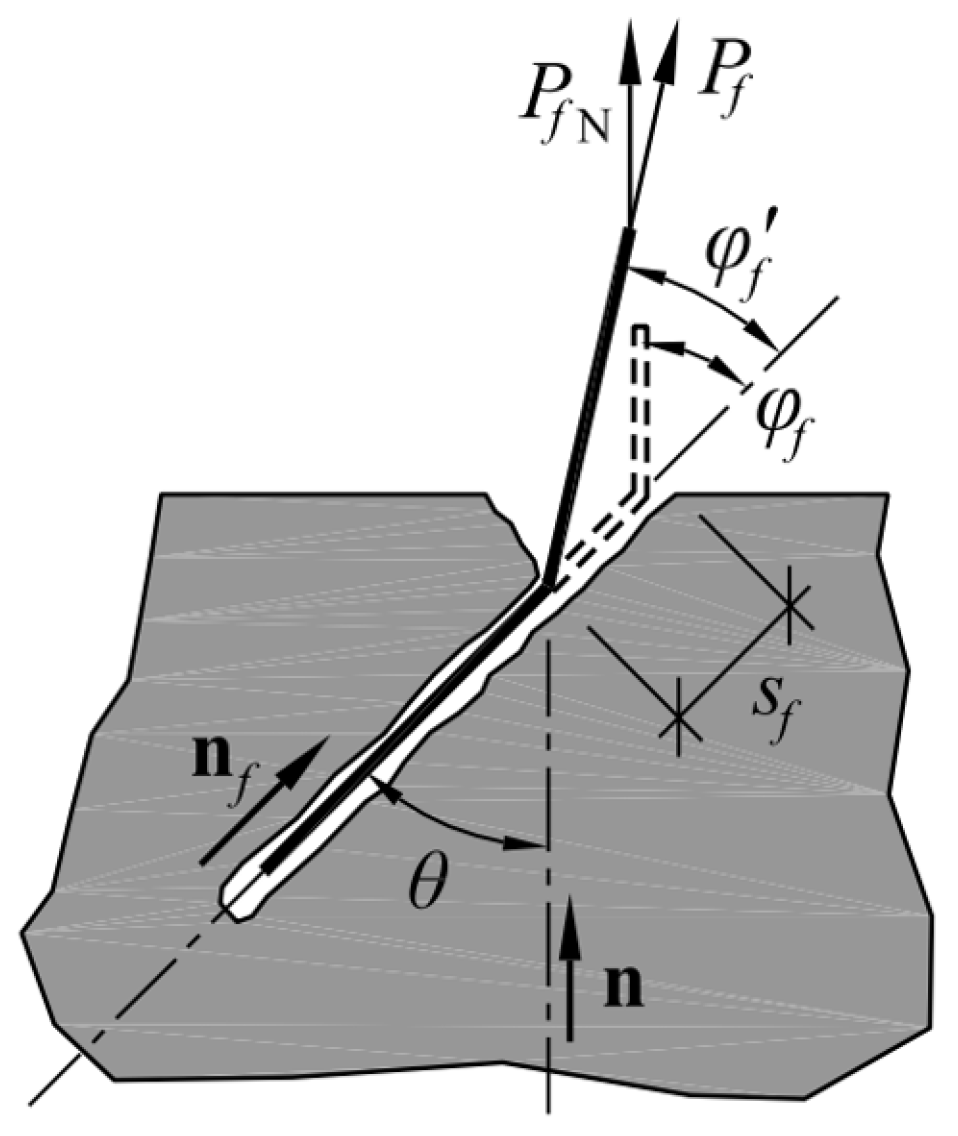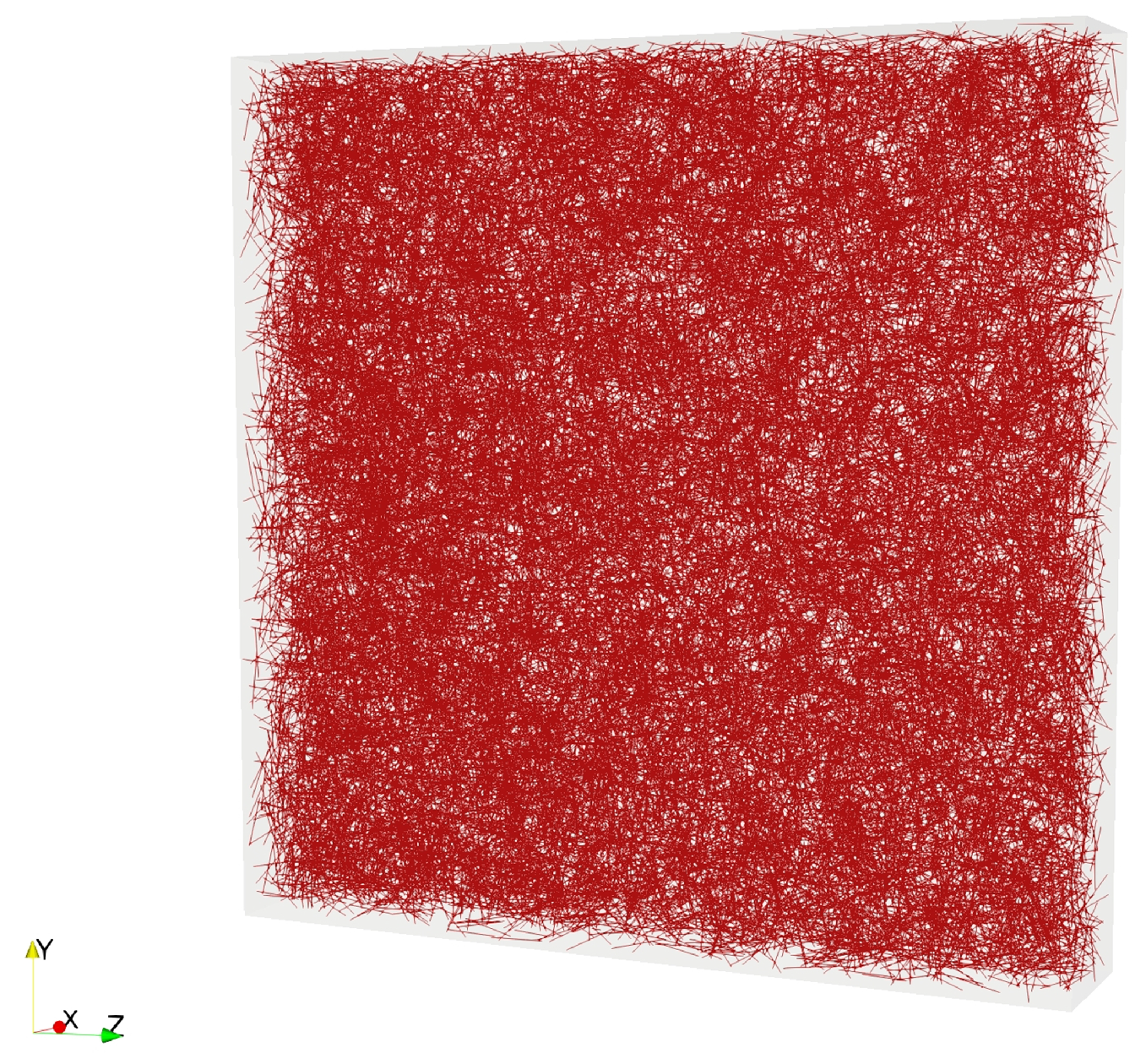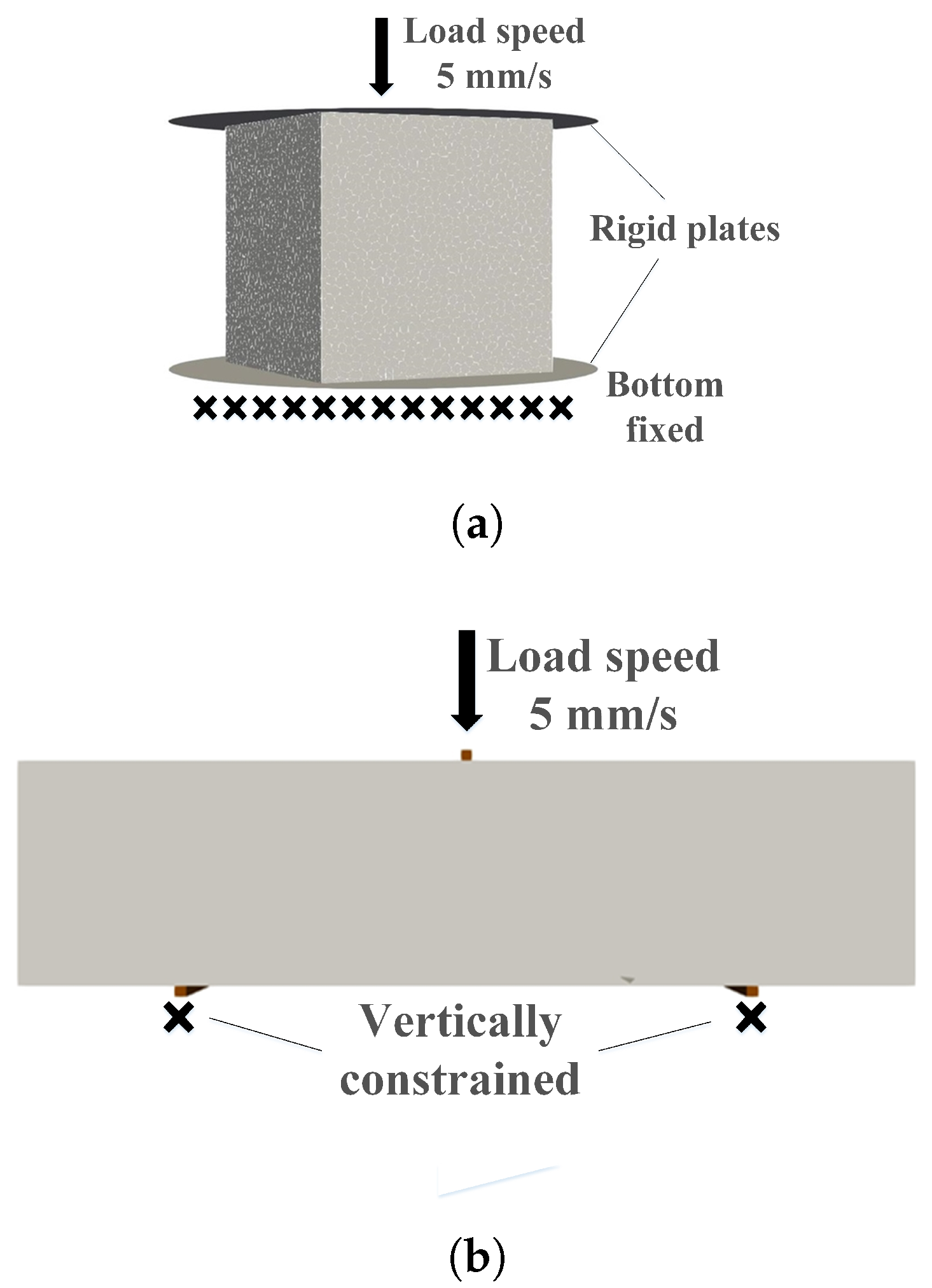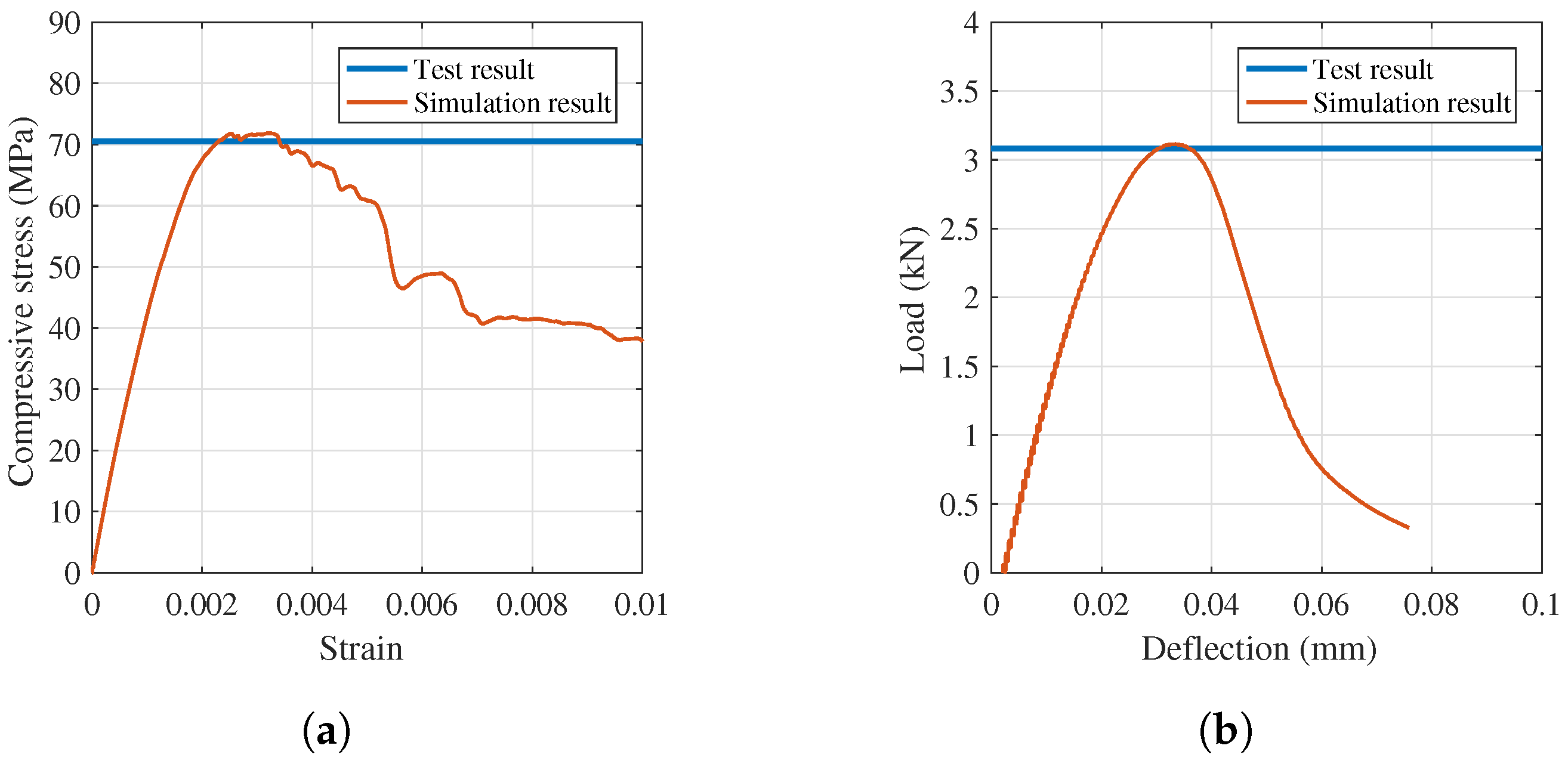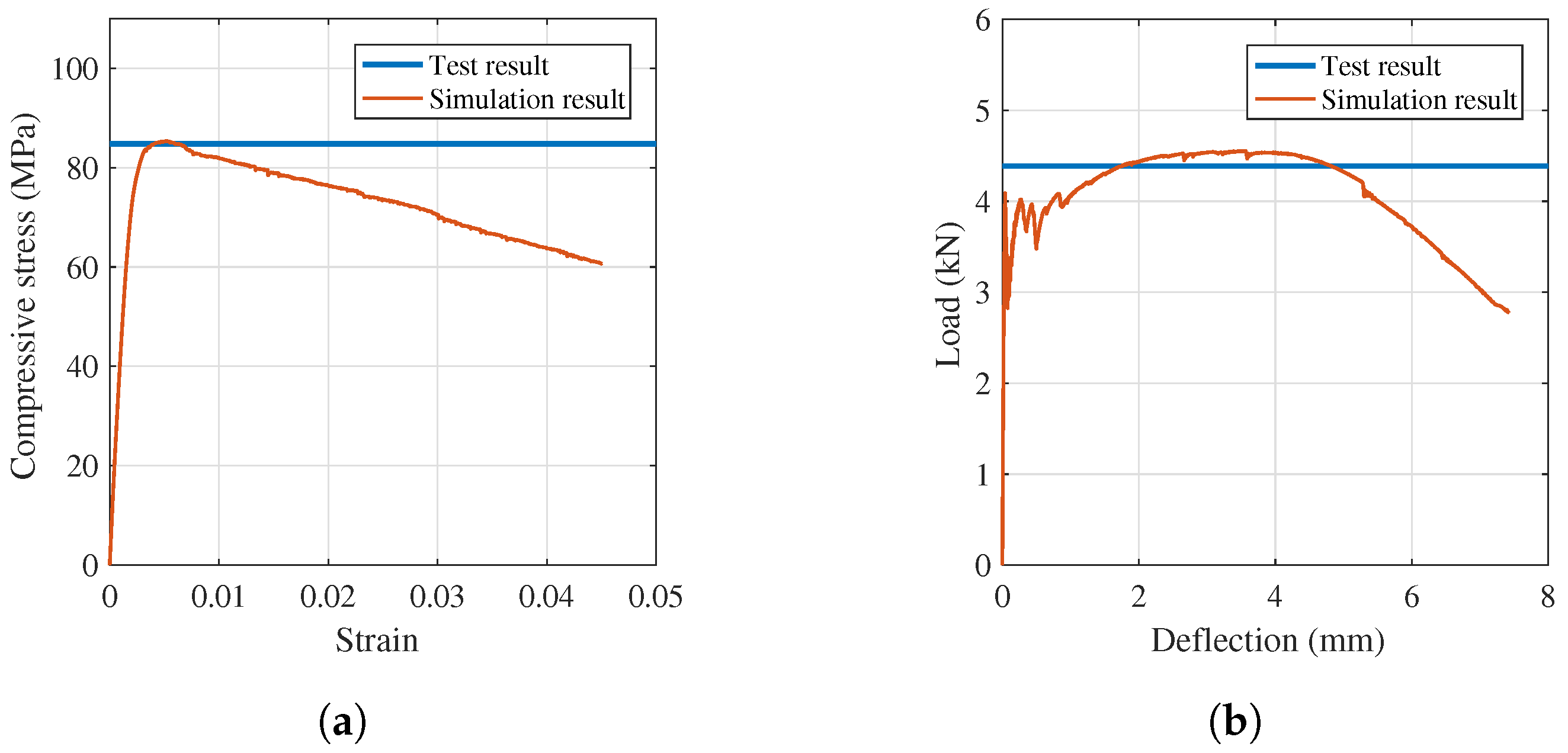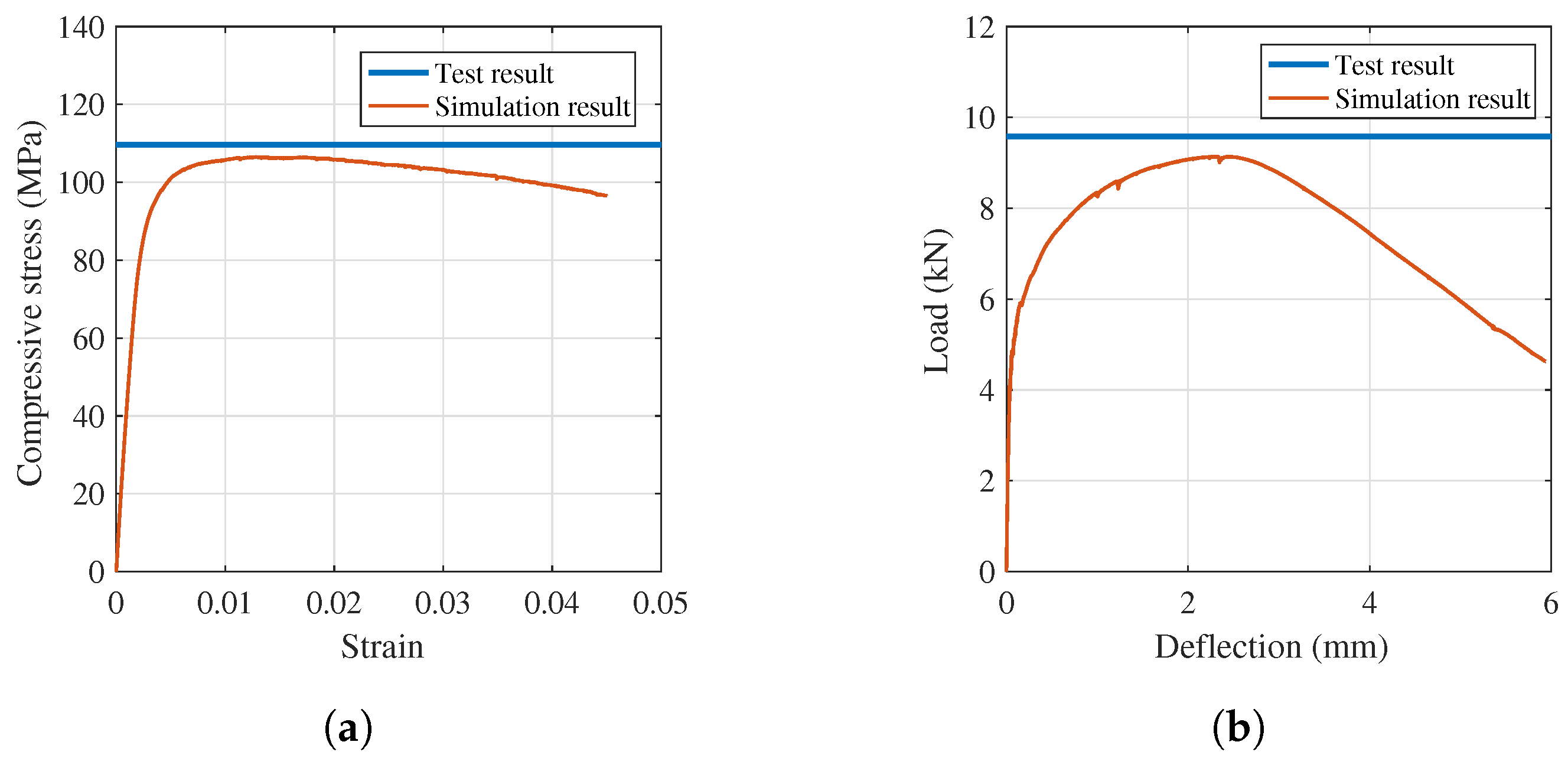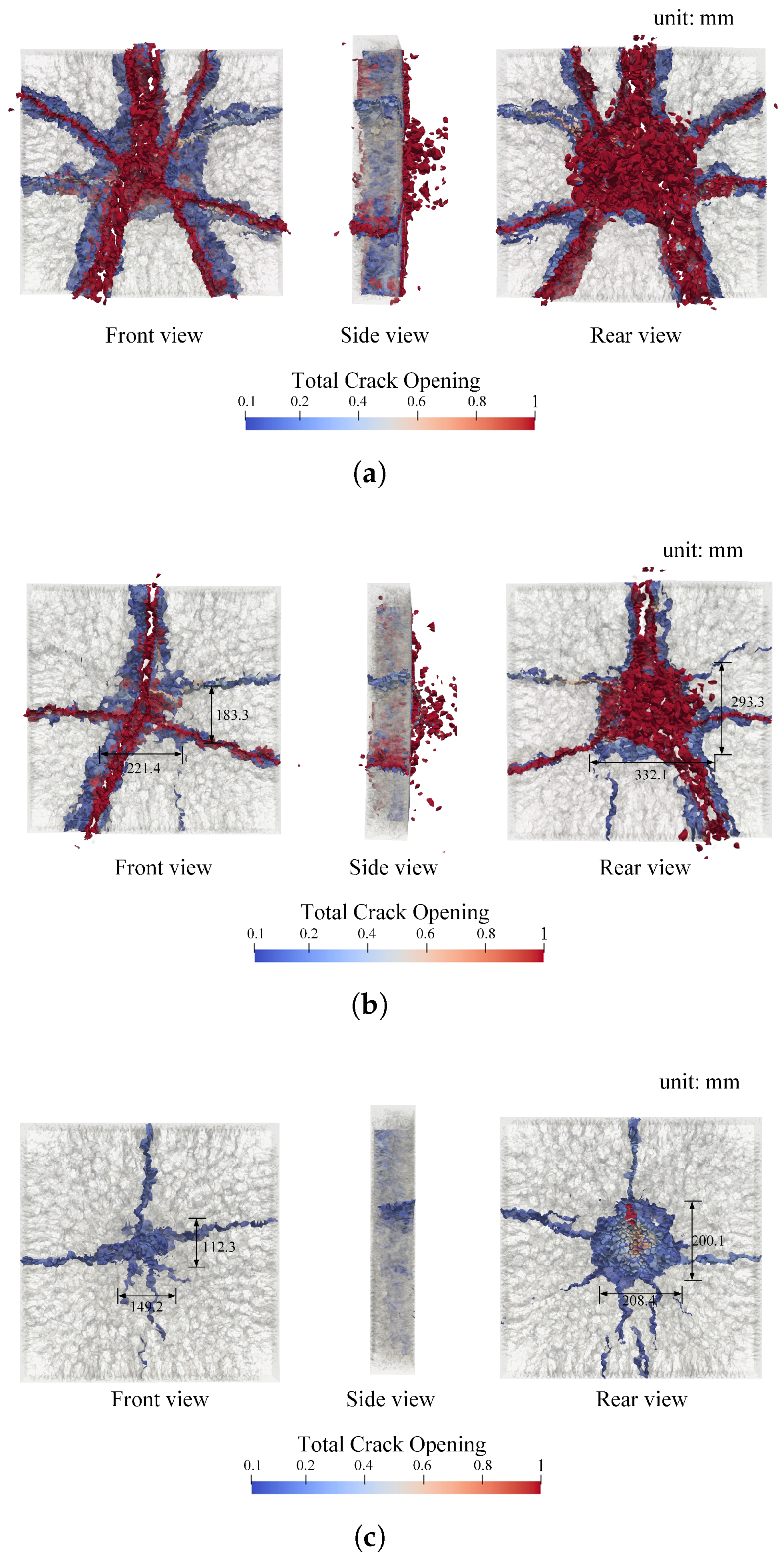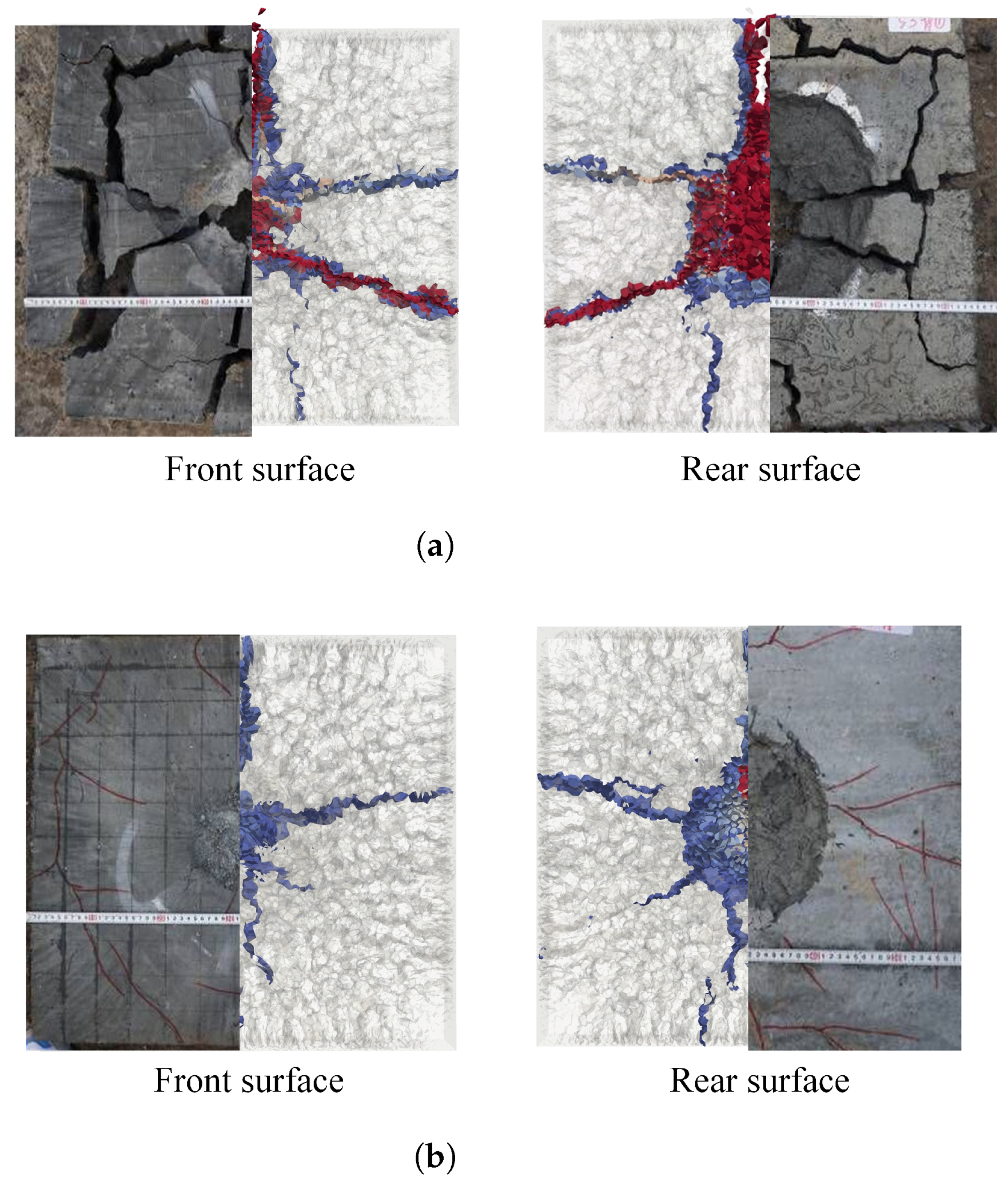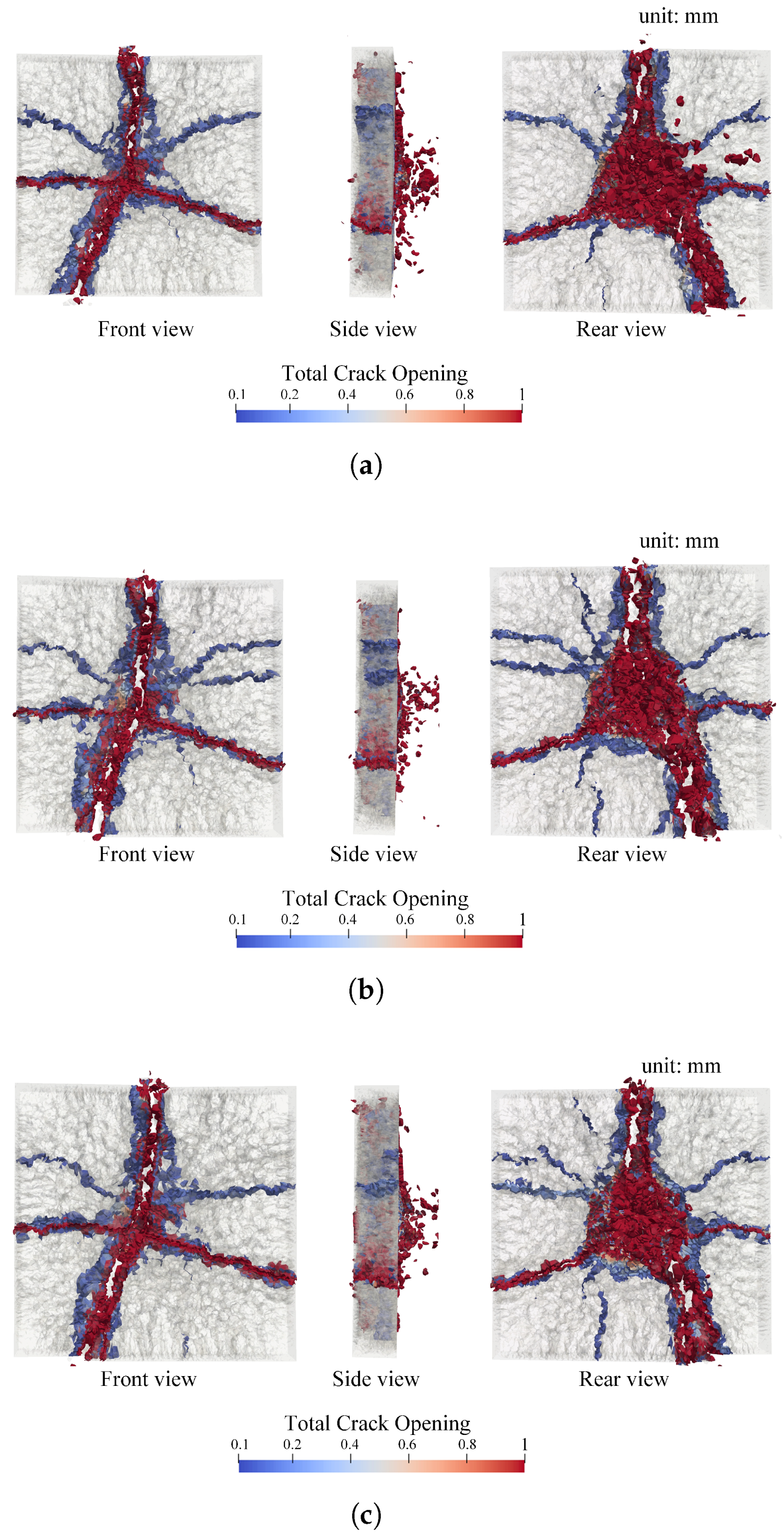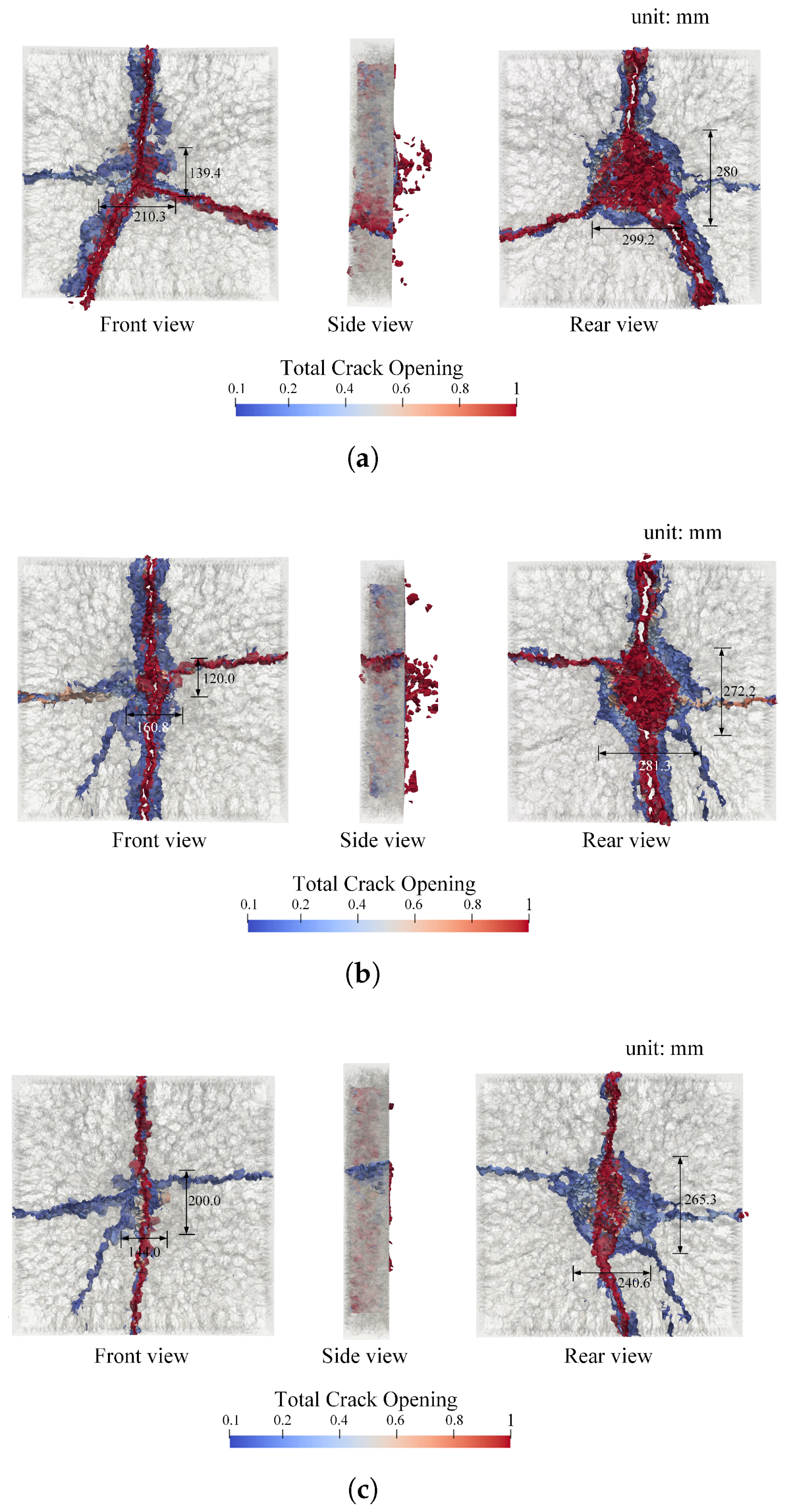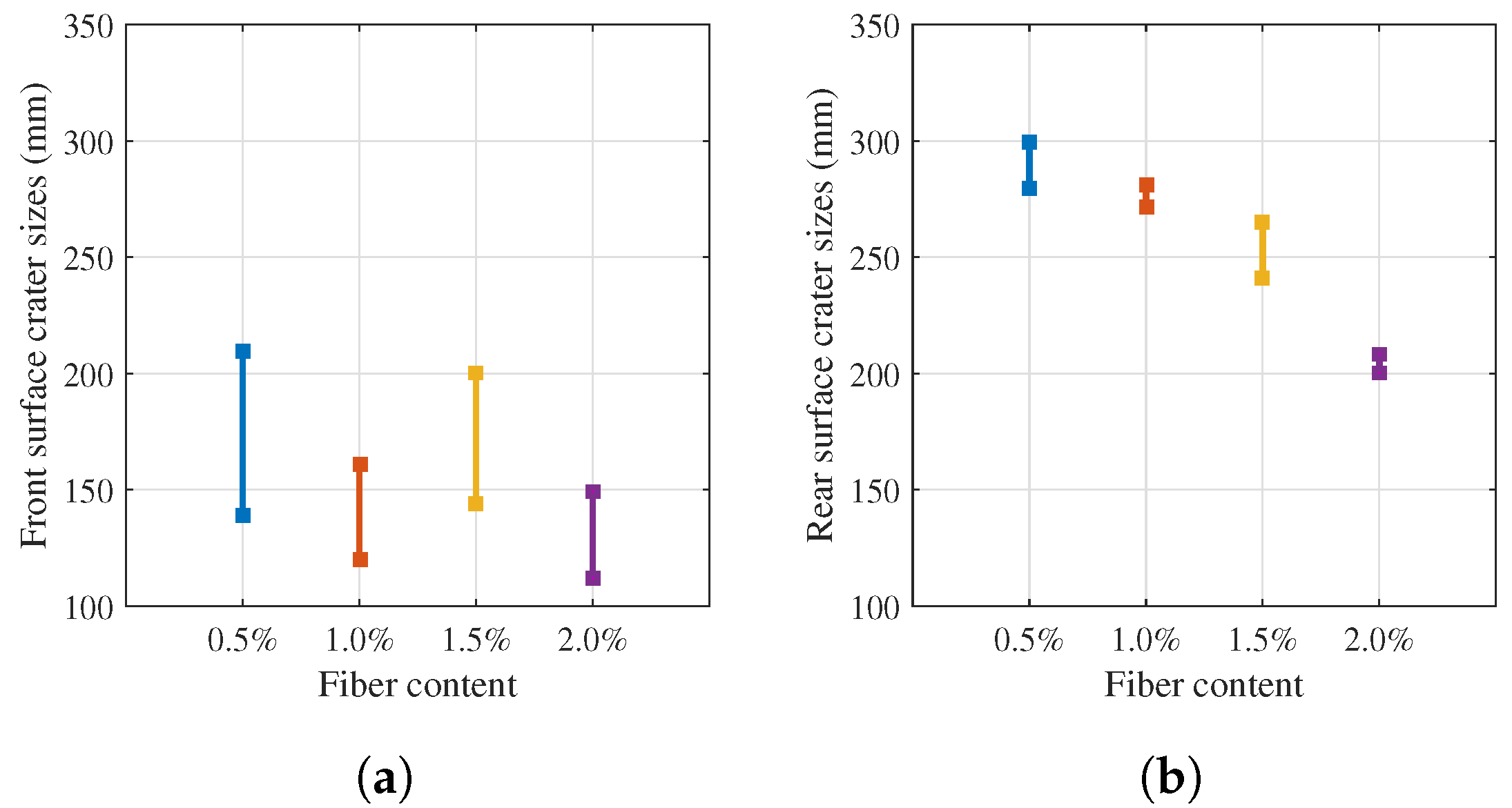Figure 1.
Fibers used for steel fiber-reinforced concrete (SFRC) and polyvinyl alcohol (PVA) fiber-reinforced concrete (PVA-FRC).
Figure 1.
Fibers used for steel fiber-reinforced concrete (SFRC) and polyvinyl alcohol (PVA) fiber-reinforced concrete (PVA-FRC).
Figure 2.
Setup of the uniaxial compression test.
Figure 2.
Setup of the uniaxial compression test.
Figure 3.
Setup of the three-point bending test.
Figure 3.
Setup of the three-point bending test.
Figure 4.
Failure modes of tested and simulated specimens after 3PBT. (a) Test results, (b) Simulation results.
Figure 4.
Failure modes of tested and simulated specimens after 3PBT. (a) Test results, (b) Simulation results.
Figure 5.
Fiber reinforcement effect on compressive and flexure strength.
Figure 5.
Fiber reinforcement effect on compressive and flexure strength.
Figure 6.
Blast test setup. (a) Test setup, (b) Top view.
Figure 6.
Blast test setup. (a) Test setup, (b) Top view.
Figure 7.
Damage modes of specimens after contact detonation. (a) S1-1, (b) S1-2, (c) S2-1 front, (d) S2-1 rear, (e) S2-2 front, (f) S2-2 rear, (g) S3-1 front, (h) S3-1 rear, (i) S3-2 front, (j) S3-2 rear.
Figure 7.
Damage modes of specimens after contact detonation. (a) S1-1, (b) S1-2, (c) S2-1 front, (d) S2-1 rear, (e) S2-2 front, (f) S2-2 rear, (g) S3-1 front, (h) S3-1 rear, (i) S3-2 front, (j) S3-2 rear.
Figure 8.
Crater sizes of SFRC and PVA-FRC panels. (a) Front surface, (b) Rear surface.
Figure 8.
Crater sizes of SFRC and PVA-FRC panels. (a) Front surface, (b) Rear surface.
Figure 9.
SEM images for steel fiber surface. (a) Original steel fiber, (b) Fiber after blast.
Figure 9.
SEM images for steel fiber surface. (a) Original steel fiber, (b) Fiber after blast.
Figure 10.
Lattice Discrete Particle Model (LDPM) polyhedral particles and cell discretization for a typical notched beam specimen. (a) Aggregate system, (b) Particles with interaction facets, (c) LDPM cell discretization.
Figure 10.
Lattice Discrete Particle Model (LDPM) polyhedral particles and cell discretization for a typical notched beam specimen. (a) Aggregate system, (b) Particles with interaction facets, (c) LDPM cell discretization.
Figure 11.
Spalling effect of fiber pullout.
Figure 11.
Spalling effect of fiber pullout.
Figure 12.
Fiber distribution in a panel.
Figure 12.
Fiber distribution in a panel.
Figure 13.
Simulation constrains. (a) Uniaxial compression, (b) 3-point bending test.
Figure 13.
Simulation constrains. (a) Uniaxial compression, (b) 3-point bending test.
Figure 14.
LDPM parameter calibration with test data. (a) Uniaxial compression, (b) 3-point bending test.
Figure 14.
LDPM parameter calibration with test data. (a) Uniaxial compression, (b) 3-point bending test.
Figure 15.
Comparison between simulation and PVA-FRC tests. (a) Uniaxial compression, (b) 3-point bending test.
Figure 15.
Comparison between simulation and PVA-FRC tests. (a) Uniaxial compression, (b) 3-point bending test.
Figure 16.
Comparison between simulation and SFRC tests. (a) Uniaxial compression, (b) 3-point bending test.
Figure 16.
Comparison between simulation and SFRC tests. (a) Uniaxial compression, (b) 3-point bending test.
Figure 17.
Blast simulation model.
Figure 17.
Blast simulation model.
Figure 18.
The damage modes of plain concrete (PC) and FRC under blast loadings. (a) Plain concrete (PC), (b) PVA-FRC, (c) SFRC.
Figure 18.
The damage modes of plain concrete (PC) and FRC under blast loadings. (a) Plain concrete (PC), (b) PVA-FRC, (c) SFRC.
Figure 19.
The comparison between damage modes of test and simulation results. (a) PVA-FRC, (b) SFRC.
Figure 19.
The comparison between damage modes of test and simulation results. (a) PVA-FRC, (b) SFRC.
Figure 20.
Damage modes of PVA-FRC with different fiber content under blast loadings. (a) 0.5% fiber volume fraction, (b) 1.0% fiber volume fraction, (c) 1.5% fiber volume fraction.
Figure 20.
Damage modes of PVA-FRC with different fiber content under blast loadings. (a) 0.5% fiber volume fraction, (b) 1.0% fiber volume fraction, (c) 1.5% fiber volume fraction.
Figure 21.
Damage modes of SFRC with different fiber content under blast loadings. (a) 0.5% fiber volume fraction, (b) 1.0% fiber volume fraction, (c) 1.5% fiber volume fraction.
Figure 21.
Damage modes of SFRC with different fiber content under blast loadings. (a) 0.5% fiber volume fraction, (b) 1.0% fiber volume fraction, (c) 1.5% fiber volume fraction.
Figure 22.
Crater sizes prediction of SFRC panels with different fiber content. (a) Front surface, (b) Rear surface.
Figure 22.
Crater sizes prediction of SFRC panels with different fiber content. (a) Front surface, (b) Rear surface.
Table 1.
Normalized mix proportion.
Table 1.
Normalized mix proportion.
| Cement | Fly Ash | Water | Quartz Sand | Superplasticizer |
|---|
| 1.00 | 0.125 | 0.25 | 0.45 | 0.02 |
Table 2.
Mechanical properties of fibers.
Table 2.
Mechanical properties of fibers.
| Fiber Type | Diameter (m) | Length (mm) | Density (g/cm) | Tensile Strength (MPa) | Elastic Modulus (GPa) |
|---|
| PVA | 30 | 12–15 | 1.30 | 1000 | 8 |
| Steel | 220 | 12–15 | 7.85 | 1200 | 200 |
Table 3.
Static test results.
Table 3.
Static test results.
| Test Data | PC | PVA-FRC | SFRC |
|---|
| Flexural strength (MPa) | 8.67 | 12.34 | 26.95 |
| Compressive strength (MPa) | 70.57 | 84.81 | 109.66 |
Table 4.
Concrete mixture for blast test.
Table 4.
Concrete mixture for blast test.
| No. | Quantity | PVA Fiber Volume Ratio (%) | Steel Fiber Volume Ratio (%) |
|---|
| S1 | 2 | - | - |
| S2 | 2 | 2.00 | - |
| S3 | 2 | - | 2.00 |
Table 5.
Damaged crater for each specimen.
Table 5.
Damaged crater for each specimen.
| No. | Front Crater Size (mm) | Front Crater Depth (mm) | Rear Crater Size (mm) |
|---|
| S1-1 | - | - | - |
| S1-2 | - | - | - |
| S2-1 | 245 × 320 | - | 336 × 390 |
| S2-2 | 234 × 289 | - | 207 × 273 |
| S3-1 | 139 × 156 | 20 | 230 × 290 |
| S3-2 | 152 × 204 | 33 | 241 × 280 |
Table 6.
LDPM parameters.
Table 6.
LDPM parameters.
| [MPa] | [-] | [MPa] | [MPa] | [-] | [mm] | [-] | [-] | [MPa] | [-] |
|---|
| 80,610 | 0.25 | 4.55 | 150 | 5.55 | 200 | 0.1 | 0.4 | 600 | 4 |
Table 7.
Lattice Discrete Particle Model-Fiber (LDPM-F) parameters.
Table 7.
Lattice Discrete Particle Model-Fiber (LDPM-F) parameters.
| Fiber Type | [MPa] | [-] | [MPa] | [-] | [-] | [MPa] | [N/m] | [-] | [-] |
|---|
| Steel fiber | 210,000 | 500 | 2800 | 0.2 | 0.2 | 6.0 | 0.0 | 0.0 | 0.6 |
| PVA fiber | 30,000 | 300 | 1000 | 0.0 | 0.2 | 2.5 | 3 | 0.05 | 1.0 |
Table 8.
The comparison of the PVA-FRC crater size between test and simulation results.
Table 8.
The comparison of the PVA-FRC crater size between test and simulation results.
| No. | Front Surface (mm) | Rear Surface (mm) |
|---|
| S2-1 | 245 × 320 | 336 × 390 |
| S2-2 | 234 × 289 | 207 × 273 |
| Simulation prediction | 183 × 221 | 293 × 332 |
Table 9.
The comparison of the SFRC crater size between test and simulation results.
Table 9.
The comparison of the SFRC crater size between test and simulation results.
| No. | Front Surface (mm) | Rear Surface (mm) |
|---|
| S3-1 | 139 × 156 | 230 × 290 |
| S3-2 | 152 × 204 | 241 × 280 |
| Simulation prediction | 112 × 149 | 200 × 208 |
Table 10.
The crater sizes of SFRC with different fiber content.
Table 10.
The crater sizes of SFRC with different fiber content.
| Fiber Content | Front Surface (mm) | Rear Surface (mm) |
|---|
| 0.5% | 139 × 210 | 280 × 299 |
| 1.0% | 120 × 161 | 272 × 281 |
| 1.5% | 200 × 144 | 265 × 241 |
| 2.0% | 112 × 149 | 200 × 208 |

